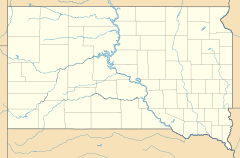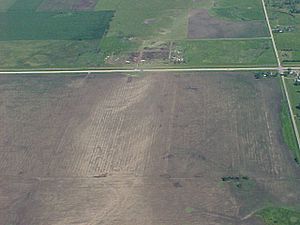Manchester, South Dakota facts for kids
Quick facts for kids
Manchester, South Dakota
|
|
|---|---|
| Country | United States |
| State | South Dakota |
| County | Kingsbury |
| Area | |
| • Total | 55.7 sq mi (144.4 km2) |
| • Land | 55.7 sq mi (144.4 km2) |
| • Water | 0.0 sq mi (0.0 km2) |
| Elevation | 1,608 ft (490 m) |
| Population
(2000)
|
|
| • Total | 40 |
| • Density | 2.0/sq mi (0.8/km2) |
| Time zone | UTC-6 (Central (CST)) |
| • Summer (DST) | UTC-5 (CDT) |
| ZIP code |
57353
|
| Area code(s) | 605 |
| FIPS code | 46-40500 |
| GNIS feature ID | 1268540 |
Manchester was once a small, unincorporated community in Kingsbury County, located in the east-central part of South Dakota. On June 24, 2003, a very powerful F4-rated tornado completely destroyed the town. After this event, Manchester became a ghost town. In 2004, the state of South Dakota officially removed Manchester as a town. According to the 2000 census, only 40 people lived there. Today, a few signs of the former town still remain.
A Look Back: Manchester's Story
Manchester was first known as Fairview. It later got its current name from Chester H. Manchester, who was the town's first postmaster. When the railroad arrived, Manchester grew quickly. Many buildings were constructed, including homes, a town hall, grocery stores, and even a high school. There were also two churches, a hotel, and a newspaper.
Grace Ingalls Dow, who was the sister of Little House on the Prairie author Laura Ingalls Wilder, lived a big part of her adult life in Manchester. She worked as a teacher at the local school and passed away in 1941. Her sister, Mary Ingalls, also lived with her for some time. Laura Ingalls Wilder herself spent many years in De Smet, a town seven miles east of Manchester along the same railroad line. Several of her Little House books are set there.
Changes Through the Years
As the 20th century began, the Chicago & Northwestern Railroad line through Manchester became less important. This meant fewer trains came through, which slowed down the town's growth. Many people started to leave. This trend continued during the Great Depression. The railroad line was used less, and more residents had to close their businesses and move to find work.
Even though a road finally reached Manchester in the late 1930s, not much was left to keep people there. The few remaining residents either passed away or moved to nearby towns like De Smet or Huron. Manchester's population kept shrinking. Eventually, fewer than 100 people remained, mostly living on farms outside the town. In 1986, the CNW railroad announced it would permanently stop using the line. However, they later sold the tracks to the Dakota, Minnesota and Eastern Railroad. By 2003, only a few buildings were left in Manchester, including two businesses, along US-14 and 425th Avenue.
The Day Manchester Disappeared
On June 24, 2003, a powerful type of thunderstorm called a supercell formed over eastern South Dakota. This storm created a tornado. The tornado grew larger and wider, taking on a "wedge" shape. It reached an F4 rating on the Fujita scale, which measures tornado strength. Its width was between half a mile and one mile as it entered Manchester.
Many weather experts and storm chasers followed the tornado. They tracked the storm's rotating core, known as a mesocyclone. A small device was placed directly in the tornado's path. The tornado passed right over this device, collecting amazing weather data. It survived winds that were once thought to be up to 260 miles per hour (418 km/h). The device also measured a huge drop in air pressure, about 100 millibars, near the center of the half-mile wide tornado. Today, winds in an EF4-rated tornado are estimated to be between 166 and 200 miles per hour (267–322 km/h).
Manchester was a very small town. Its center was right at the intersection of US Highway 14 and 425th Avenue, surrounded by farmland. The tornado hit the town from the south. It caused strong F3 to F4 damage, easily destroying the few old buildings left in the town center, including the post office. Several other buildings along US-14 were also destroyed. According to Dan Kight from the Kingsbury County Sheriff's department, "There's a business that's partially left, but everything else is gone." He also mentioned that only three or four families lived in Manchester. Some residents were taken to the hospital with injuries.
Storm chaser Tim Samaras placed several special "turtle probes" in the tornado's path. One of these probes was hit directly by the tornado. It recorded a pressure drop of 100 millibars in just five seconds. This was the biggest and fastest pressure drop ever recorded directly by any instrument during a weather event. The powerful winds of the tornado even scoured the gravel from the road where the probe was placed. However, when the probe was picked up, there was still gravel underneath it.




